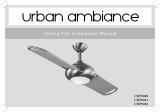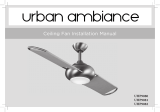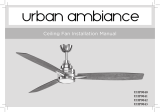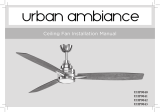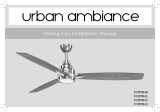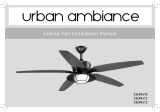Page is loading ...

• CEILING FAN OWNER'S MANUAL •
Read and Save These Instructions
• Casou •
203215A
203217A

TOOLS AND MATERIALS REQUIRED
Unpack your fan and check the contents.
You should have the following items:
a. Blade set (3)
b. Hanger bracket assembly
c. Downrod
d. Coupling cover
e. Fan motor assembly
f. Mounting plate
g. LED Light kit
h. Glass shade
i. Light housing
j. Receiver+3 wire nuts
k. Transmitter+holder+2 mounting screws
l. 9 Volt battery
m. Package hardware:
1) Mounting hardware:
screws (2), lock washers (2), star washers (2), wire
nuts (3), wood screws (2)
2) Blade attachment hardware:
screws (10), fiber washers (10)
3) Balance Kit
1
PACKAGE CONTENTS
Philips screw driver
Blade screw driver
11 mm wrench
Step ladder
Wire cutters
a
b
c
d
e
f
g
h
i
j
k
l
m

SAFETY RULES
2
1. To reduce the risk of electric shock, insure
electricity has been turned off at the circuit
breaker or fuse box before beginning.
2. All wiring must be in accordance with the National
Electrical Code and local electrical codes.
Electrical installation should be performed by a
qualified licensed electrician.
3. WARNING: To reduce the risk of electrical shock
and fire, do not use this fan with any solid-state
fan speed control device.
4. WARNING:To reduce the risk of fire, electric shock,
or personal injury, mount to outlet box marked
"acceptable for fan support of 15.8 kg (35 lbs.) or
less" and use mounting screws provided with the
outlet box. Most outlet boxes commonly used for
the support of light fixtures are not acceptable for
fan support and may need to be replaced. Due
to the complexity of the installation of this fan, a
qualified licensed electrician is strongly
recommended.
5. The outlet box and support structure must be
securely mounted and capable of reliably
supporting a minimum of 50 pounds. Use only
UL/CUL Listed outlet boxes marked "FOR FAN
SUPPORT".
6. The fan must be mounted with a minimum of 7
feet clearance from the trailing edge of the
blades to the floor.
7. Do not operate reversing switch while fan blades
are in motion. Fan must be turned off and blades
stopped before reversing blade direction.
8. Avoid placing objects in the path of the blades.
9. To avoid personal injury or damage to the fan
and other items, be cautious when working
around or cleaning the fan.
10. Do not use water or detergents when cleaning
the fan or fan blades. A dry dust cloth or lightly
dampened cloth will be suitable for most
cleaning.
11. After marking electrical connections, spliced
conductors should be turned upward and
pushed carefully up into outlet box. The wires
should be spread apart with the grounded
conductor and the equipment-grounding
conductor on one side of the outlet box.
12. Electrical diagrams are reference only. Light kit
that are not packed with the fan must be UL/CUL
Listed and marked suitable for use with the
model fan you are installing. Switches must be
UL/CUL General Use Switches. Refer to the
Instructions packaged with the light kits and
switches for proper assembly.
WARNING
TO REDUCE THE RISK OF FIRE, ELECTRIC SHOCK OR
PERSONAL INJURY, MOUNT FAN TO OUTLET BOX
MARKED
"ACCEPTABLE FOR FAN SUPPORT".
WARNING
TO REDUCE THE RISK OF PERSONAL INJURY, DO
NOT BEND THE BLADE BRACKETS (ALSO
REFERRED TO AS FLANGES) DURING ASSEMBLY
OR AFTER INSTALLATION. DO NOT INSERT
OBJECTS IN THE PATH OF THE BLADES.
THIS FAN IS EQUIPPED WITH A 75
WATT LIMITING DEVICE.IF LAMPING EXCEEDS 75
WATTS,THE CEILING FAN’S LIGHT KIT WILL SHUT
OFF AUTOMATICALLY.

MOUNTING OPTIONS
3
If there isn't an existing UL/CUL listed mounting box,
then read the following instructions. Disconnect the
power by removing fuses or turning off circuit
breakers.
Secure the outlet box directly to the building
structure. Use appropriate fasteners and building
materials. The outlet box and its support must be
able to fully support the moving weight of the fan (at
least 35 lbs). Do not use plastic outlet boxes.
Figures 1,2 and 3 are examples of different ways to
mount the outlet box.
NOTE:
You may need a longer downrod to maintain
proper blade clearance when installing on a steep,
sloped ceiling. (Fig. 3)
To hang your fan where there is an existing fixture but
no ceiling joist, you may need an installation hanger
bar as shown in Figure 4.
Outlet box
Provide strong
support
Recessed
outlet box
Outlet box
Outlet box
Fig. 1
Fig. 2
Fig. 3
Fig. 4
Ceiling
mounting
plate
Angled ceiling
maximum
20° angle

HANGING THE FAN
4
REMEMBER: to turn off the power. Follow the steps
below to hang your fan properly:
Step 1. Remove the decorative canopy bottom
cover from the canopy by turning the cover counter
clockwise. (Fig. 5)
Step 2. Remove the hanger bracket from the
canopy by removing the 1 of 2 screws from the
bottom of the hanger bracket and loosening the
other one a half turn from the screw head. Next, turn
the canopy counter clockwise to removing the
hanger bracket from the canopy. (Fig. 5)
Step 3. Pass the 120-volt supply wires through the
center hole in the ceiling hanger bracket as shown in
Fig. 6.
Step 4. Secure the hanger bracket to the ceiling
outlet box with the screws and washers provided with
your outlet box.
Step 5. Remove the hanger pin, lock pin and set
screws from the top of the motor assembly.
Step 6. Route wires and safety cable exiting from the
top of the fan motor through the collar cover,
canopy cover, canopy and then through the ball /
downrod. (Fig. 7)
Step 7. Align the holes at the bottom of the downrod
with the holes in the collar on top of the motor
housing. (Fig.7) Carefully insert the hanger pin
through the holes in the collar and downrod. Be
careful not to jam the pin against the wiring inside
the downrod. Insert the locking pin through the hole
near the end of the hanger pin until it snaps into its
locked position. (Fig. 7)
WARNING: Failure to properly install the cotter pin
could result in the fan loosening and possibly falling.
Step 8. Tighten two set screws on top of the fan
motor firmly. (Fig. 7)
Step 9. Place the downrod ball into the hanger
bracket socket. (Fig. 8)
“**REQUIRED FOR INSTALLATIONS IN CANADA**”
Step 10. Secure the safety cable to the ceiling joist
with screw and washer (not included). (Fig. 8)
Fig. 5
Fig. 6
Fig. 7
Fig. 8
Downrod
Canopy
Set screws
Hitch pin
Lock pin
Canopy cover
Coupling cover
Mounting
bracket
UL/CUL Listed
electrial
box
120V Wires
Hook
Mounting screws
(supplied with
electrical box)
Registration slot
Safety cable
Ceiling hanger
bracket
Ceiling
canopy
Canopy
cover

5
MAKE THE ELECTRIC CONNECTIONS
WARNING: To avoid possible electrical shock, be sure
electricity is turned off at the main fuse box before
wiring.
NOTE:
This remote control unit is equipped with 16
code combinations to prevent possible interference
from or to other remote units. The frequency switches
on your receiver and transmitter have been preset at
the factory. Please recheck to make sure the
switches on transmitter and receiver are set to the
same position, any combination of settings will
operate the fan as long as the transmitter and
receiver are set to the same position. (Figure 9)
Step 1. (Figure 10) Insert the receiver into the
mounting bracket with the flat side of the receiver
facing the ceiling.
Step 2. (Figure 11) Motor to Receiver Electrical
Connections: Connect the black wire from the fan to
black wire marked "TO MOTOR L". Connect the white
wire from the fan to the white wire marked "TO
MOTOR N" from the receiver. Connect the Blue wire
from the fan to the Blue wire marked "For Light" from
the receiver. Secure wire connections with the plastic
wire nuts provided.
Step 3. (Figure 11) Receiver to House Supply Wires
Electrical Connections: Connect the black (hot) wire
from the ceiling to the black wire marked "AC in L"
from the receiver. Connect the white (neutral) wire
from the ceiling to the white wire marked "AC in N"
from the Receiver. Secure the wire connections with
the plastic wire nuts provided.
Fig. 9
Fig. 10
Code switch
ON
ON
Receiver
Hanger
bracket

6
Step 4. (Figure 11) If your outlet box has a ground
wire (green or bare copper) connect it to the fan
ground wires; otherwise connect the hanging bracket
ground wire to the mounting bracket. Secure the wire
connection with a plastic nut provided. After
connecting the wires, spread them apart so that the
green and white wires are on one side of the outlet
box and black and blue wires are on the other side.
Carefully tuck the wire connections up into the outlet
box.
NOTE:
Fan must be installed at a maximum distance
of 30 feet from the transmitting unit for proper signal
transmission between the transmitting unit and the
fan's receiving unit.
Step 1. Tuck connections neatly into ceiling outlet
box.
Step 2. Slide the canopy up to hanger bracket and
place the key hole on the canopy over the screw on
the hanger bracket, turn canopy until it locks in place
at the narrow section of the key holes.
Step 3. Align the circular hole on canopy with the
remaining hole on the hanger bracket, secure by
tightening the two set screws.
NOTE:
Adjust the canopy screws as necessary until
the canopy and canopy cover are snug. (Fig. 12)
WARNING:
Make sure tab at bottom of hanger
bracket is properly seated in groove of hanger ball
before attaching canopy to bracket. Failure to
properly seat tab in groove could cause damage to
electrical wiring.
Fig. 11
Fig. 12
Hanger
bracket
FINISHING THE INSTALLATION
White (neutral)
White (neutral)
Green or bare
copper (ground)
White ("AC IN N")
White ("to motor N")
Ground
(green)
(Connect to
ground wire on
hanger bracket
if no house
ground wire
exists.)
Outlet box
Black (hot)
Black ("AC IN L")
Black ("to motor L")
Receiver
Black (motor)
Blue (for light)
Blue (for light)
Outlet box
Hanger
bracket
Canopy
Canopy cover
Screws

ATTACHING THE FAN BLADES
7
INSTALLATING THE MOUNTING PLATE
Step 1. Remove the 1 of 3 screws from the mounting
ring and loosen the other 2 screws. (Do not remove)
Step 2. Place the key holes on the mounting plate
over the 2 screws previously loosened from the
mounting ring, turn mounting plate until it locks in
place at the narrow section of the key holes. Secure
by tightening the 2 screws previously loosened and
the one previously removed. (Fig. 14)
Step 1. Attach the blade to the blade bracket using
the screws and fiber washers as shown in Figure 13.
Start screw into bracket. Repeat for the remaining
screws.
Step 2. Tighten each screw. Make sure the blade is
straight.
Fig. 13
Fig. 14
Screws
Fiber
washers
Blade
Blades bracket
Screws
Mounting ring
Mounting
plate

INSTALLING THE LED LIGHT KIT
8
INSTALLATING THE GLASS SHADE AND LIGHT HOUSING
Step 1. Raise glass shade up against LED light kit and
secure it to the fan by turning the glass shade
clockwise until snug. DO NOT OVERTIGHTEN. (Fig. 16)
Step 2. Raise light housing up against mounting plate
and secure it to the fan by using the screws and
rubber washers provided. (Fig. 16)
NOTE:
Before starting installation, disconnect the
power by turning off the circuit breaker or removing
the fuse at fuse box. Turning power off using the fan
switch is not sufficient to prevent electric shock.
Step 1. Remove the 1 of 3 screws from the posts of
the mounting plate and keep it for future use. Loosen
the other 2 screws. (Do not remove) (Fig. 16)
Step 2. Raise and hold the LED light kit close to the
mounting plate and proceed to do the wire
connections. Connect the white wire connectors
from the light kit and fan, follow the same procedure
with the black wire connectors. (Fig. 15)
Step 3. Place the key holes in the LED light kit over
the two screws previously loosened from the
mounting plate. Turn the LED light kit until the LED light
kit locks in place at the narrow section of the key
holes. Securely tighten the two light kit mounting
screws previously loosened and the one previously
removed.
Fig. 15
Fig. 16
Connection plugs
Screws
LED Light kit
Rubber
washers
Screws
Glass
shade
Light
housing
Mounting
plate
Mounting
plate

INSTALLING THE BATTERY
9
OPERATING YOUR TRANSMITTER
Install 9 volt battery (included), to prevent damage to
transmitter, remove the battery if not used for long
periods. (Fig. 17)
Restore power to ceiling fan and test for proper
operation.
1. HI, MED, and LOW buttons:
These three buttons are used to set the fan speed as
follows:
HI= high speed
Med= medium speed
Low= low speed
2. OFF button:
This button turns the fan off.
3. The " " button turns the light ON or OFF and also
controls the brightness setting. Press and release the
button to turn the light ON or OFF. Press and hold the
button to set the desired brightness. The light key has
an auto-resume, it will stay at the same brightness as
the last time it was turned off.
Fig. 17
Fig. 18
9
V
o
l
t
B
a
t
t
e
r
y

10
The Reverse switch is located on the top of the motor
housing. Slide the switch to the Left for warm weather
operation. Slide the switch to the Right for cool
weather operation.
Speed settings for warm or cool weather depend on
factors such as the room size. Ceiling height, number
of fans and so on.
NOTE: Wait for fan to stop before changing the
setting of the slide switch.
Warm weather - (Forward) A downward airflow
creates a cooling effect as shown in Fig. 19. This
allows you to set your air conditioner on a warmer
setting without affecting your comfort.
Cool weather - (Reverse) An upward airflow moves
warm air off the ceiling area as shown in Fig. 20. This
allows you to set your heating unit on a cooler setting
without affecting your comfort.
Fig. 19
Fig. 20
OPERATING YOUR TRANSMITTER (CONTINUED)

CARE OF YOUR FAN
11
Here are some suggestions to help you maintain your fan
1. Because of the fan's natural movement, some connections may become loose. Check the support
connections, brackets, and blade attachments twice a year. Make sure they are secure. (It is not
necessary to remove fan from ceiling.)
2. Clean your fan periodically to help maintain its new appearance over the years. Use only a soft brush or
lint-free cloth to avoid scratching the finish. The plating is sealed with a lacquer to minimize discoloration
or tarnishing. Do not use water when cleaning. This could damage the motor, or the wood, or possibly
cause an electrical shock.
3. You can apply a light coat of furniture polish to the wood blades for additional protection and enhanced
beauty. Cover small scratches with a light application of shoe polish.
4. There is no need to oil your fan. The motor has permanently lubricated bearings.
IMPORTANT
Make sure the power is off at the electrical panel box before you attempt any repairs. Refer to the
section "making electrical connections".

TROUBLESHOOTING
12
Problem
Fan will not start.
Fan sounds noisy.
Remote control
malfunction.
Lights shut off and
will not come back
on.
Fan wobble.
Solution
1. Check circuit fuses or breakers.
2. Check line wire connections to the fan and switch wire connections in the switch
housing. CAUTION: Make sure main power is off.
3. Check to make sure the dip switches from the transmitter and receiver are set to
the same frequency.
1. Make sure all motor housing screws are snug.
2. Make sure the screws that attach the fan blade bracket to the motor hub is tight.
3. Make sure wire nut connections are not rubbing against each other or the interior
wall of the switch housing. CAUTION: Make sure main power is off.
4. Allow a 24-hour "breaking-in" period. Most noise associated with a new fan
disappear during this time.
5. If using an optional light kit, make sure the screws securing the glassware are tight.
Check that light bulb is also secure.
6. Do not connect the fan with wall mounted variable speed control (s).
7. Make sure the upper canopy is a short distance from the ceiling. It should not
touch the ceiling.
1. Do not connect the fan with wall mounted variable speed control (s).
2. Make sure the dip switches are set correctly.
1. This unit is equipped with a wattage limiting device. Lamping in excess of 75 watts
will disable your ceiling fan's light kit. To reset your light kit, you must turn the power
off and relamp, keeping the wattage under 75 watts. Restore power to your ceiling
fan and continue normal operation.
1. Check that all blade and blade arm screws are secure.
2. Most fan wobbling problems are caused when blade levels are unequal. Check
this level by selecting a point on the ceiling above the tip of one of the blades.
Measure this distance. Rotate the fan until the next blade is positioned for
measurement. Repeat for each blade. The distance deviation should be equal
within 1/8".
3. Use the enclosed Blade Balancing Kit if the blade wobble is still noticeable.
4. If the blade wobble is still noticeable, interchanging two adjacent (side by side)
blades can redistribute the weight and possibly result in smoother operation.
WARNING: To reduce the risk of personal injury, do not bend the blade arm while
installing, balancing the blades, or cleaning the fan. Do not insert foreign objects
between rotating fan blades.

SPECIFICATIONS
13
19.00
lbs
22.11
lbs
2.52'
Fan Size Speed
Volts
Amps
Watts
RPM
CFM
N.W. G.W. C.F.
52"
Low
High
120
120
These are approximate measures. They do not include Amps and Wattage used by the light kit.
0.23
0.55
11.84
65.53
64
165
1947
5036
/

